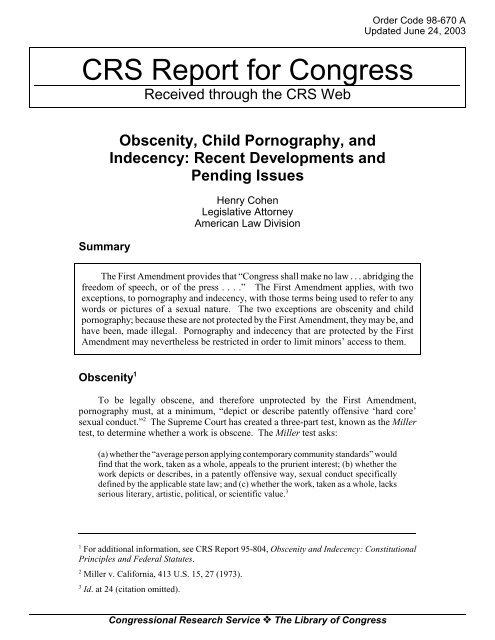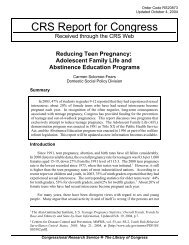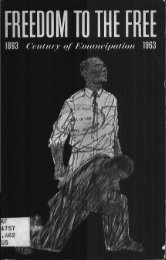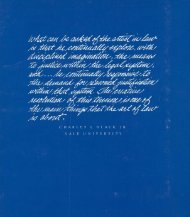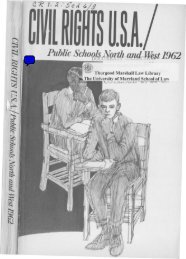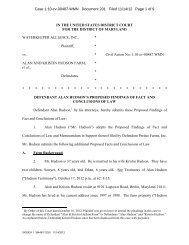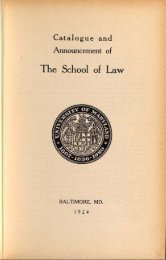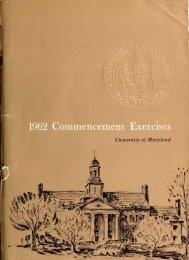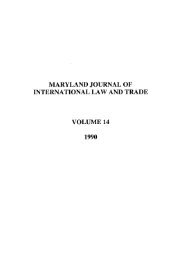Obscenity, Child Pornography, and Indecency - University of ...
Obscenity, Child Pornography, and Indecency - University of ...
Obscenity, Child Pornography, and Indecency - University of ...
Create successful ePaper yourself
Turn your PDF publications into a flip-book with our unique Google optimized e-Paper software.
CRS Report for Congress<br />
Received through the CRS Web<br />
Summary<br />
<strong>Obscenity</strong>, <strong>Child</strong> <strong>Pornography</strong>, <strong>and</strong><br />
<strong>Indecency</strong>: Recent Developments <strong>and</strong><br />
Pending Issues<br />
1 For additional information, see CRS Report 95-804, <strong>Obscenity</strong> <strong>and</strong> <strong>Indecency</strong>: Constitutional<br />
Principles <strong>and</strong> Federal Statutes.<br />
2 Miller v. California, 413 U.S. 15, 27 (1973).<br />
3 Id. at 24 (citation omitted).<br />
Henry Cohen<br />
Legislative Attorney<br />
American Law Division<br />
Congressional Research Service ˜ The Library <strong>of</strong> Congress<br />
Order Code 98-670 A<br />
Updated June 24, 2003<br />
TheFirstAmendmentprovidesthat“Congressshallmakenolaw...abridgingthe<br />
freedom<strong>of</strong>speech,or<strong>of</strong>thepress....” TheFirstAmendmentapplies,withtwo<br />
exceptions, to pornography <strong>and</strong> indecency, with those terms being used to refer to any<br />
words or pictures <strong>of</strong> a sexual nature. The two exceptions are obscenity <strong>and</strong> child<br />
pornography; because these are not protected by the First Amendment, they may be, <strong>and</strong><br />
have been, made illegal. <strong>Pornography</strong> <strong>and</strong> indecency that are protected by the First<br />
Amendment may nevertheless be restricted in order to limit minors’ access to them.<br />
<strong>Obscenity</strong> 1<br />
To be legally obscene, <strong>and</strong> therefore unprotected by the First Amendment,<br />
pornography must, at a minimum, “depict or describe patently <strong>of</strong>fensive ‘hard core’<br />
sexual conduct.” 2 The Supreme Court has created a three-part test, known as the Miller<br />
test, to determine whether a work is obscene. The Miller test asks:<br />
(a) whether the “average person applying contemporary community st<strong>and</strong>ards” would<br />
find that the work, taken as a whole, appeals to the prurient interest; (b) whether the<br />
work depicts or describes, in a patently <strong>of</strong>fensive way, sexual conduct specifically<br />
defined by the applicable state law; <strong>and</strong> (c) whether the work, taken as a whole, lacks<br />
serious literary, artistic, political, or scientific value. 3
4 481 U.S. 497, 500 (1987).<br />
5 521 U.S. 844 (1997).<br />
6 Id. at 877-878.<br />
CRS-2<br />
In Pope v. Illinois, the Supreme Court clarified that “the first <strong>and</strong> second prongs <strong>of</strong><br />
the Miller test — appeal to prurient interest <strong>and</strong> patent <strong>of</strong>fensiveness — are issues <strong>of</strong> fact<br />
for the jury to determine applying contemporary community st<strong>and</strong>ards.” However, as for<br />
the third prong, “[t]he proper inquiry is not whether an ordinary member <strong>of</strong> any given<br />
community would find serious literary, artistic, political, or scientific value in allegedly<br />
obscene material, but whether a reasonable person would find such value in the material,<br />
taken as a whole.” 4<br />
<strong>Obscenity</strong>: Recent Developments. The Communications DecencyAct <strong>of</strong> 1996<br />
(P.L. 104-104, § 507) exp<strong>and</strong>ed the law prohibiting the importation <strong>of</strong>, or interstate<br />
commerce in, obscenity (18 U.S.C. §§ 1462, 1465) to apply to the use <strong>of</strong> an “interactive<br />
computer service” for that purpose. It defined “interactive computer service” to include<br />
“a service or system that provides access to the Internet.” 47 U.S.C. § 230(e)(2). These<br />
provisions were not affected by the Supreme Court’s decision in Reno v. American Civil<br />
Liberties Union declaring unconstitutional two provisions <strong>of</strong> the CDA that would have<br />
restricted indecency on the Internet. 5<br />
<strong>Obscenity</strong>: Pending Issues. In Reno, the Court noted, in dictum, that “the<br />
‘community st<strong>and</strong>ards’ criterion as applied to the Internet means that any communication<br />
available to a nationwide audience will be judged by the st<strong>and</strong>ards <strong>of</strong> the community most<br />
likely to be <strong>of</strong>fended by the message.” 6 This suggested that, at least with respect to<br />
obscenity on the Internet, the Court might replace the community st<strong>and</strong>ards criterion,<br />
except perhaps in the case <strong>of</strong> Internet services where the defendant makes a<br />
communication available only to subscribers <strong>and</strong> can thereby restrict the communities in<br />
which he makes a posting accessible. However, in Ashcr<strong>of</strong>t v. American Civil Liberties<br />
Union, decided May 13, 2002, the Court held that the use <strong>of</strong> community st<strong>and</strong>ards does<br />
not by itself render a statute banning “harmful to minors” material on the Internet<br />
unconstitutional. (See below under “<strong>Indecency</strong>.”)<br />
<strong>Child</strong> <strong>Pornography</strong> 7<br />
<strong>Child</strong> pornography is material “that visually depict[s] sexual conduct by children<br />
below a specified age.” 8 It is unprotected by the First Amendment even when it is not<br />
obscene; i.e., child pornography need not meet the Miller test to be banned. 9 The reason<br />
that child pornography is unprotected is that it “is intrinsically related to the sexual abuse<br />
<strong>of</strong>children.... Indeed,thereisnoseriouscontentionthatthelegislaturewasunjustified<br />
7 For additional information, see CRS Report 95-406, <strong>Child</strong> <strong>Pornography</strong>: Constitutional<br />
Principles <strong>and</strong> Federal Statutes.<br />
8 New York v. Ferber, 458 U.S. 747, 764 (1982) (italics in original).<br />
9 This means that child pornography may be banned even if does not appeal to the prurient<br />
interest, is not patently <strong>of</strong>fensive, <strong>and</strong> does not lack literary, artistic, political, or scientific value.<br />
See Ferber, supra note 8, 458 U.S., at 764.
10 Ferber, supra note 8, 458 U.S., at 759-760.<br />
CRS-3<br />
in believing that it is difficult, if not impossible, to halt the exploitation <strong>of</strong> children by<br />
pursuing only those who produce the photographs <strong>and</strong> movies.” 10<br />
Federal law bans interstate commerce (including by computer) in child pornography<br />
(18 U.S.C. §§ 2252, 2252A), defines “child pornography” as “any visual depiction” <strong>of</strong><br />
“sexually explicit conduct” involving a minor, <strong>and</strong> defines “sexually explicit conduct” to<br />
include not only various sex acts but also the “lascivious exhibition <strong>of</strong> the genitals or<br />
pubic area <strong>of</strong> any person.” 18 U.S.C. § 2256.<br />
<strong>Child</strong> <strong>Pornography</strong>: Recent Developments. In 1994, Congress amended the<br />
child pornography statute to provide that “lascivious exhibition <strong>of</strong> the genitals or pubic<br />
area <strong>of</strong> any person” “is not limited to nude exhibitions or exhibitions in which the outlines<br />
<strong>of</strong> those areas were discernible through clothing.” 18 U.S.C. § 2252 note. This<br />
amendment expressed Congress’s support for a court decision upholding a conviction for<br />
possessing “videotapes that focus on the genitalia <strong>and</strong> pubic area <strong>of</strong> minor females . . .<br />
even though these body parts are covered by [opaque] clothing.” 11 Then, the <strong>Child</strong><br />
<strong>Pornography</strong> Prevention Act <strong>of</strong> 1996 (CPPA) created a definition <strong>of</strong> “child pornography”<br />
that included visual depictions that appear to be <strong>of</strong> a minor, even if no minor was actually<br />
used. 18 U.S.C. § 2256(8). The statute, thus, may be read to include visual depictions<br />
using adult actors who appear to be minors, as well as computer graphics <strong>and</strong> drawings<br />
or paintings done without any models.<br />
On April 16, 2002, in Ashcr<strong>of</strong>t v. Free Speech Coalition, the Supreme Court declared<br />
the CPPA unconstitutional to the extent that it prohibited pictures that were not produced<br />
with actual minors. 12 <strong>Child</strong> pornography, to be unprotected by the First Amendment,<br />
must either be obscene or depict actual children engaged in sexual activity (including<br />
“lascivious” poses), or actual children whose images have been “morphed” to make it<br />
appear that the children are engaged in sexual activity. The Court observed in Ashcr<strong>of</strong>t<br />
that statutes that prohibit child pornography that use real children are constitutional<br />
because they target “[t]he production <strong>of</strong> the work, not the content.” The CPPA, by<br />
contrast, targeted the content, not the means <strong>of</strong> production. The government’s rationales<br />
for the CPPA included that “[p]edophiles might use the materials to encourage children<br />
to participate in sexual activity” <strong>and</strong> might “whet their own sexual appetites” with it,<br />
“therebyincreasing...thesexualabuse<strong>and</strong>exploitation<strong>of</strong>actualchildren.” TheCourt<br />
found these rationales inadequate because the government “cannot constitutionally<br />
premise legislation on the desirability <strong>of</strong> controlling a person’s private thoughts” <strong>and</strong><br />
“may not prohibit speech because it increases the chance an unlawful act will be<br />
committed ‘at some indefinite future time.’”<br />
The government also argued that the existence <strong>of</strong> “virtual” child pornography “can<br />
make it harder to prosecute pornographers who do use real minors,” because, “[a]s<br />
imaging technology improves ...,itbecomesmoredifficulttoprovethataparticular<br />
picture was produced using actual children.” This rationale, the Court found, “turns the<br />
11 United States v. Knox, 977 F.2d 815, 817 (3d Cir. 1992), vacated <strong>and</strong> rem<strong>and</strong>ed, 510 U.S. 375<br />
(1993); 32 F.3d 733 (3d Cir. 1994), cert. denied, 513 U.S. 1109 (1995).<br />
12 535 U.S. 234 (2002).
CRS-4<br />
First Amendment upside down. The Government may not suppress lawful speech as a<br />
means to suppress unlawful speech.”<br />
In response to Ashcr<strong>of</strong>t, Congress enacted Title V <strong>of</strong> the Prosecutorial Remedies <strong>and</strong><br />
Other Tools to end the Exploitation <strong>of</strong> <strong>Child</strong>ren Today Act <strong>of</strong> 2003, or PROTECT Act,<br />
Public Law 108-21. This statute prohibits any “digital image, computer image, or<br />
computer-generated image that is, or is indistinguishable from, that <strong>of</strong> a minor engaging<br />
in sexually explicit conduct. It also prohibits “a visual depiction <strong>of</strong> any kind, including<br />
a drawing, cartoon, sculpture, or painting, that ...depictsaminorengaginginsexually<br />
explicit conduct,” <strong>and</strong> is obscene or lacks serious literary, artistic, political, or scientific<br />
value. Section 603 <strong>of</strong> the PROTECT Act amended the CDA to apply to child<br />
pornography transmitted via the Internet.<br />
<strong>Child</strong> <strong>Pornography</strong>: Pending Issues<br />
To the extent that the PROTECT Act prohibits non-obscene child pornography that<br />
was produced without the use <strong>of</strong> an actual child, it may be challenged as unconstitutional.<br />
<strong>Indecency</strong> 13<br />
“<strong>Indecency</strong>” has no precise definition. The Supreme Court has said that “the normal<br />
definition <strong>of</strong> ‘indecent’ merely refers to nonconformance with accepted st<strong>and</strong>ards <strong>of</strong><br />
morality.” 14 More specifically, the term has been defined as material that “depicts or<br />
describes, in terms patently<strong>of</strong>fensive as measured bycontemporarycommunityst<strong>and</strong>ards,<br />
sexual or excretory activities or organs.” 15<br />
Indecent material is protected bythe First Amendment unless it constitutes obscenity<br />
or child pornography. Indecent material that is protected by the First Amendment may<br />
be restricted by the government only “to promote a compelling interest” <strong>and</strong> only by “the<br />
least restrictive means to further the articulated interest.” 16 The Supreme Court has<br />
“recognized that there is a compelling interest in protecting the physical <strong>and</strong> psychological<br />
well-being <strong>of</strong> minors. This interest extends to shielding minors from the influence <strong>of</strong><br />
literature that is not obscene by adult st<strong>and</strong>ards.” 17<br />
13 For additional information, see CRS Report 95-804, <strong>Obscenity</strong> <strong>and</strong> <strong>Indecency</strong>: Constitutional<br />
Principles <strong>and</strong> Federal Statutes.<br />
14 Federal Communications Commission v. Pacifica Foundation, 438 U.S. 726, 740 (1978).<br />
15 This quotation is from 47 U.S.C. § 223(d), a provision <strong>of</strong> the CDA that the Supreme Court held<br />
unconstitutional. This definition is similar to the FCC’s definition <strong>of</strong> “indecent” in the context<br />
<strong>of</strong> dial-a-porn <strong>and</strong> broadcast media. See, Dial Information Services Corp. v. Thornburgh, 938<br />
F.2d 1535, 1540 (2d Cir. 1991), cert. denied, 502 U.S. 1072 (1992); Pacifica, supra note 14, 438<br />
U.S., at 732.<br />
16 Sable Communications <strong>of</strong> California v. Federal Communications Commission, 492 U.S. 115,<br />
126 (1989).<br />
17 Id.
CRS-5<br />
There are federal statutes in effect that limit, but do not ban, indecent material<br />
transmitted via telephone, broadcast media, <strong>and</strong> cable television. 18 There are also many<br />
state statutes that ban the distribution to minors <strong>of</strong> material that is “harmful to minors.”<br />
Material that is “harmful to minors” under these statutes tends to be defined more<br />
narrowly than material that is “indecent,” in that material that is “harmful to minors” is<br />
generally limited to material <strong>of</strong> a sexual nature that has no serious value for minors. The<br />
Supreme Court has upheld New York’s “harmful to minors” statute. 19<br />
<strong>Indecency</strong>: Recent Developments. In 1997, the Supreme Court declared<br />
unconstitutional two provisions <strong>of</strong> the Communications Decency Act <strong>of</strong> 1996 that would<br />
have prohibited indecent communications, by telephone, fax, or e-mail, to minors, <strong>and</strong><br />
would have prohibited use <strong>of</strong> an “interactive computer service” to display indecent<br />
material “in a manner available to a person under 18 years <strong>of</strong> age.” 20 This latter<br />
prohibition would have banned indecency from public (i.e., non-subscription) Web sites.<br />
The CDA was succeeded by the <strong>Child</strong> Online Protection Act (P.L. 105-277), which<br />
differs from the CDA in two main respects: (1) it prohibits communication to minors only<br />
<strong>of</strong> “material that is harmful to minors,” rather than material that is indecent, <strong>and</strong> (2) it<br />
applies only to communications for commercial purposes on publicly accessible Web<br />
sites. “Material that is harmful to minors” is defined as material that (A) is prurient, as<br />
determined by community st<strong>and</strong>ards, (B) “depicts, describes, or represents, in a manner<br />
patently <strong>of</strong>fensive with respect to minors,” sexual acts or a lewd exhibition <strong>of</strong> the genitals<br />
or post-pubescent female breast, <strong>and</strong> (C) “lacks serious literary, artistic, political, or<br />
scientific value for minors.” A communication is deemed to be for “commercial<br />
purposes” if it is made in the regular course <strong>of</strong> a trade or business with the objective <strong>of</strong><br />
earning a pr<strong>of</strong>it. Requiring a viewer to use a credit card to gain access to the material<br />
would constitute a defense to prosecution. The law was scheduled to take effect on<br />
November 20, 1998, but a suit challenging it was filed, <strong>and</strong> a federal district court in<br />
Philadelphia, finding that there was a likelihood that the plaintiffs would prevail, issued<br />
a preliminary injunction against enforcement <strong>of</strong> the statute pending a trial on the merits. 21<br />
The Third Circuit upheld the preliminary injunction, <strong>and</strong>, on May 13, 2002, the Supreme<br />
Court vacated <strong>and</strong> rem<strong>and</strong>ed the Third Circuit’s decision, but did not remove the<br />
preliminary injunction. On March 6, 2003, the Third Circuit again affirmed the district<br />
court’s preliminary injunction.<br />
<strong>Indecency</strong>: Pending Issues. In light <strong>of</strong> the Supreme Court’s decision in Reno,<br />
is the <strong>Child</strong> Online Protection Act constitutional? The primary problem the Court found<br />
with the CDA was that, “[i]n order to deny minors access to potentially harmful speech,<br />
18 47 U.S.C. § 223(b) (commercial dial-a-porn), 18 U.S.C. § 1464, 47 U.S.C. § 303 note<br />
(broadcast media), 47 U.S.C. §§ 531(e), 532(c)(2), 532(h), 559-561 (cable television). The<br />
Supreme Court declared section 561 unconstitutional. United States v. Playboy Entertainment<br />
Group, Inc. v. United States, 529 U.S. 803 (2000).<br />
19 Ginsberg v. New York, 390 U.S. 629 (1968).<br />
20 Reno v. American Civil Liberties Union, supra, note 5.<br />
21 American Civil Liberties Association v. Reno, 31 F. Supp.2d 473 (E.D. Pa., 1999), aff’d, 217<br />
F.3d 162 (3d Cir. 2000), vacated <strong>and</strong> rem<strong>and</strong>ed sub nom. Ashcr<strong>of</strong>t v. American Civil Liberties<br />
Union, 535 U.S. 564 (2002), aff’donrem<strong>and</strong>,322 F.3d 240 (3d Cir. 2003).
22 Reno, supra note 5, at 874.<br />
CRS-6<br />
the CDA effectively suppresses a large amount <strong>of</strong> speech that adults have a constitutional<br />
right to receive <strong>and</strong> to address to one another.” 22 The fact that COPA does not apply to<br />
material with serious literary, artistic, political, or scientific value for minors, <strong>and</strong> that it<br />
applies only to commercial Web sites, makes it more likely than the CDA to be upheld.<br />
Nevertheless it may well, like the CDA, be found to “suppress[ ] a large amount <strong>of</strong> speech<br />
that adults have a constitutional right to receive <strong>and</strong> to address to one another.” This is<br />
because a Web site that is freely accessible, but is deemed “commercial” because it seeks<br />
to make a pr<strong>of</strong>it through advertisements, would apparently have to stop making its Web<br />
site freely accessible, or, in the alternative, would have to remove all words <strong>and</strong> pictures<br />
that might be deemed “harmful to minors” according to the st<strong>and</strong>ards <strong>of</strong> the community<br />
most likely to be <strong>of</strong>fended by the material. In its May 13, 2002 decision, the Supreme<br />
Court held that COPA’s use <strong>of</strong> community st<strong>and</strong>ards does not by itself render the statute<br />
unconstitutional, but it rem<strong>and</strong>ed the case to the Third Circuit to consider whether it is<br />
unconstitutional nonetheless, <strong>and</strong> the Third Circuit held that it is.<br />
The <strong>Child</strong>ren’s Internet Protection Act (CIPA), P.L. 106-554 23<br />
CIPA restricts access to obscenity, child pornography, <strong>and</strong> material that is “harmful<br />
to minors,” <strong>and</strong> so is discussed here separately. CIPA amended three federal statutes to<br />
provide that a school or library may not use funds it receives under these statutes to<br />
purchase computers used to access the Internet, or to pay the direct costs <strong>of</strong> accessing the<br />
Internet, <strong>and</strong> may not receive universal service discounts, unless the school or library<br />
enforces a policy to block or filter minors’ Internet access to visual depictions that are<br />
obscene, child pornography, or harmful to minors; <strong>and</strong> enforces a policy to block or filter<br />
adults’ Internet access to visual depictions that are obscene or child pornography. It<br />
provides, however, that filters may be disabled “for bona fide research or other lawful<br />
purposes.”<br />
On May31, 2002, a three-judge federal district court declared CIPA unconstitutional<br />
<strong>and</strong> enjoined its enforcement ins<strong>of</strong>ar as it applies to libraries. (The provisions affecting<br />
schools were not challenged.) The government appealed directly to the Supreme Court,<br />
which, on June 23, 2003, reversed the district court, holding CIPA constitutional. 24 The<br />
plurality opinion acknowledged “the tendency <strong>of</strong> filtering s<strong>of</strong>tware to ‘overblock’ – that<br />
is, to erroneously block access to constitutionally protected speech that falls outside the<br />
categories that s<strong>of</strong>tware users intend to block.” It found, however, that, “[a]ssuming that<br />
such erroneous blocking presents constitutional difficulties, any such concerns are<br />
dispelled by the ease with which patrons may have the filtering s<strong>of</strong>tware disabled.” The<br />
plurality also found that CIPA does not deny a benefit to libraries that do not agree to use<br />
filters; rather, the statute “simply insist[s] that public funds be spent for the purposes for<br />
which they were authorized.”<br />
23 P.L. 106-554 incorporated H.R. 5666, 106 th Congress, Title 17 <strong>of</strong> which is CIPA.<br />
24 United States v. American Library Association, No. 02-316 (U.S., June 23, 2003).


